- Home
- Orson Scott Card
Earth Afire (The First Formic War) Page 8
Earth Afire (The First Formic War) Read online
Page 8
Mazer blinked the appropriate commands to begin the sequence and saw that Reinhardt, the pilot, was doing the same. Avionics? Check. Load talons? Check. Gravity lens? Check.
The HERC—or heavy equipment recovery copter—was a scooper, a low-flying aircraft designed to rush into hostile territory; scoop up troops, vehicles, or supplies; and get out as quickly as possible. Since it was primarily used for extraction and not direct combat, it didn’t pack a lot of heavy air support. Yet what it lacked in big guns, it made up for in armor. The standing joke on base was that a tank and a helicopter had done the funky watusi in the bushes, and the HERC had popped out nine months later.
Yet to call the HERC a mere flying tank was an insult to its design. Engineered by Juke Limited, the HERC was the world’s first gravity-lensing aircraft, which used lenses to deflect gravity waves from Earth and send them around the aircraft. The lenses were not mechanical lenses like glass lenses that refracted light, but rather fields created by a center point. By adjusting the shape of the field, it adjusted the direction that gravity waves were focused or deflected. The result was the aircraft felt less gravity. It hovered. It flew without rotor blades. And because gravity lensing adjusted continuously to provide vertical placement above the Earth’s surface, all that was needed to make the HERC fly forward was a means of propulsion, which the rear jet engine provided.
It took very powerful computers to constantly adjust the direction, focus, and strength of the gravlens, however. And computers, when rattled in combat, tended to fail. As a backup, in case the gravlens gave out and the aircraft dropped like a stone, Juke Limited had installed rotor blades as well. When not in use the blades folded into a single blade that tied back parallel to the main line of the aircraft like a cockroach’s wings. These could deploy in 0.3 seconds, which, in high altitude, was more than enough time to keep the HERC airborne. But since the HERC was almost exclusively a low-flying aircraft, normally going no higher than twenty meters above the trees to avoid detection and enemy fire, the backup rotor blades wouldn’t deploy fast enough to save the crew. If anything, they would merely lessen the impact. And even then the rotors would do as much harm as good. Once you hit the ground the torque effects from the blades would take over and flop the bird around or try to drill it into the ground. You were almost better off deploying the huge emergency chutes, keeping the rotor blades off, and praying the airbags kept you alive.
Mazer tried not to think about crashing, focusing instead on the assignment at hand. The order had come directly from the Ministry of Defence six months ago. The NZSAS—or New Zealand Special Air Services, the special forces branch of the kiwi military based out of South Auckland—was to put the HERC through rigorous field tests to determine the aircraft’s combat readiness.
Mazer had been tasked as flight-team leader, and the commission had come as a surprise. He had no training as a test pilot, and he had been in the NZSAS for less than two years. As far as he could tell, there was a line of men a kilometer long who were far more qualified.
“Don’t let it go to your head,” Reinhardt had told him. “When the colonel gives assignments like this, it doesn’t mean he likes you. It means you’re expendable. You think they want their best guys dying in field tests? Hell no. They want us getting the bugs out. We’re guinea pigs, Rackham. Crash-test dummies. Bottom of the totem pole.”
It was a joke of course. In the NZSAS, there were no totem poles. Every man was equal. There were chains of command, yes, but no one pulled rank or dumped unfavorable assignments on greenies. In the unit, no job was beneath any soldier. If a ditch needed digging, Colonel Napatu was as likely to grab a shovel as anyone else.
“Check and clear,” said Reinhardt, finishing up the preflight sequence.
“Check and clear,” Mazer repeated.
Behind the cockpit, Patu banged the butt of her rifle twice on the floor. “Let’s get a move on and get this over with. I haven’t slept in thirty-six hours.”
Beside her, Fatani closed his eyes and laid his head against the headrest. “None of us have slept in that long, Patu. We all need our beauty sleep.” Fatani was a hundred and twenty kilos of Polynesian muscle, well over two meters tall. The safety restraints around his chest were extended to maximum length, but even so the fit was tight.
“You try to get beauty sleep, Fatani?” Reinhardt asked with mock surprise. “You must suffer from some serious insomnia.”
“Keep it up, Reinhardt,” said Fatani. “We’ll see how long you laugh when I drop your skinny butt from this bucket at three hundred and twenty kilometers per hour.”
“You’d only kill yourself,” said Reinhardt. “Birds tend to crash without a pilot.”
“I can pilot as well as you can.”
“Yeah, and by the time you crawled up here into the seat, you’d be crashing into the ground.”
“Then I’d die with a smile on my face, knowing I had just dropped you.”
“Enough with the testosterone,” Patu said. “Can we go now, please?”
“Blue River, Blue River,” Mazer said into his helmet. “This is Jackrabbit. We are clear and flight-ready, over.”
“Roger that, Jackrabbit,” came the voice over the radio. “You are clear to go. Mission sequence code: lima tango four zero seven foxtrot, over.”
Mazer entered the code into his HUD and repeated the sequence back to the controller. Windows of data popped up as the computer accepted the code and opened the mission file. Mazer blinked the command to forward the files to everyone else. A timer in the upper right corner of his HUD began ticking up the seconds from zero. It was a timed mission, apparently.
Reinhardt initiated the gravlens, and the HERC lifted a few meters into the air. Even after all these months, the silence of the whole operation unnerved Mazer. He had done hundreds of hours in traditional helicopters, and his mind had become accustomed to the roar of the engines and the thump thump thump of rotor blades. To hear nothing but the almost imperceptible purr of the computers felt completely unnatural.
Then Reinhardt initiated the rear engine, and Mazer got that all-too-familiar sick feeling in his stomach as the HERC shot forward over the tarmac and headed north. Mazer pushed the sensation aside and focused on the intel. “Target is latitude negative thirty-seven degrees, zero minutes, twenty-one point seven seven two two seconds. Longitude one hundred seventy-five degrees, ten minutes, thirty-seven point five one six two seconds.”
“Coordinates confirmed,” said Patu.
“Identify target,” said Fatani.
The HERC shot up another fifteen meters as they approached the tree line, heading up into the hills of the Hunua Ranges and leaving the airfield behind them. Mazer instinctively put a hand on the instrument panel to steady himself. “Target is an AT-90 Copperhead. Crew of two. Both seriously wounded.”
Copperheads were squat assault tanks loaded with enough firepower to level a small city. They were also ridiculously heavy and hard to carry because of their wide, shallow design.
“Whose turn is it to play medic?” asked Fatani.
“Yours,” said Patu. “And don’t ask me to cover for you. I bandaged up the last two rounds of guys.”
“They better not be bleeders,” said Fatani. “I hate the bleeders.”
For field tests and war exercises like this one, the NZSAS used rubberized dummies for their casualties. Mazer and his unit were to treat the dummies like real soldiers and administer lifesaving first aid as part of the exercise. The bleeders were the worst. Loaded with red syrupy paint, they added a good two to three hours to cleanup time and put everyone in a bad mood.
The Copperhead tank would be a dummy as well. Probably a burned-out bus or ATV pulled from the scrap heap and loaded with enough weight to resemble a Copperhead. The Colonel wouldn’t use a real one and risk damaging it.
“So what’s the deal, Lieutenant?” asked Reinhardt. “Is this operation a final exam or something? Why all the secrecy?”
“No idea,” said Mazer. “Co
lonel said to be ready to fly at 0300, and we’d get our orders then.”
“Seems strange to me,” said Fatani. “Normally we’re the ones designing the field tests. Now all of a sudden the colonel’s doing it for us. No briefing. No prep. Just strap in and wait for orders.”
“Combat’s no different,” said Patu. “Makes perfect sense to me. Brass wants to see how the HERC manages when we’re not controlling all the variables. Think about it. Before we run a test, we determine everything. Where it flies, what the weather’s like, where the enemy is located, what their capabilities are. But what team in real combat is going to have all that intel?”
“Pilots would at least know what the weather was like,” said Reinhardt. “It’s the first thing they teach you in pilot school. When the windshield wipers are on, it’s raining outside.”
“You’re hilarious,” said Patu.
“All I’m saying,” said Fatani, “is that if this is some kind of exam, it would’ve been nice to have known that ahead of time.”
“Has to be,” said Patu. “That’s why they didn’t let us sleep. They want to know if exhausted pilots flying with limited intel can pull off a HERC mission.”
“If that’s the case, they’re testing us as much as the HERC,” said Fatani.
“It doesn’t matter,” said Mazer. “We do what we always do. We scoop up the target and we bring it home.”
The secretive nature of the operation didn’t bother Mazer. He was used to sporadic psychological tests like this; it went with the territory in special forces. Someone was always running you to the point of exhaustion and then denying you water and keeping you up for another twenty-four hours. Or they were messing with your head in some other way: isolating you, or dropping you in the middle of nowhere with a blindfold over your eyes and telling you to return to base using only your other senses. Compared to those tests, this surprise mission with the HERC was a cakewalk.
A message appeared on Mazer’s HUD.
“Hostile territory in three point four kilometers,” said Mazer.
A second later there was a flash and a boom to their right as a flare exploded not ten meters from the cockpit. Flares were used as surface-to-air missiles—or STAs—in war games. It was all show and no shrapnel, but it still startled everyone on board.
“Whoa!” said Reinhardt, pushing the stick forward and dipping the HERC into a stomach-churning descent.
“Hey!” said Patu, slamming back into her seat. “Easy on the dips.”
Mazer grabbed the window bar to his right and tried to keep his focus on the data on his HUD.
“I’d say we got bad intel,” said Reinhardt. “We’re in hostile territory already.” Two more explosions lit up the night sky, one on each side of the aircraft.
“Fatani!” shouted Mazer.
“I’m going, I’m going,” said Fatani.
A section of the floor beneath Fatani slid away, exposing the gunnery dome on the underside of the HERC. Fatani worked the joystick on his seat and lowered himself into the dome, seat and all. The thickly forested hills of the Hunua Ranges rushed beneath him, the treetops just visible in the darkness. Fatani made a final adjustment, and the top hook of his seat latched into the swivel mount, suspending him in place and giving him the ability to spin and maneuver in any direction. A small window on Mazer’s HUD showed him Fatani’s POV, and Mazer watched as the butt of the laser cannon slid into position and locked on to Fatani’s chest harness.
“Locked!” shouted Fatani.
“Acquiring targets,” said Mazer.
More of the dummy STAs were shooting off around them, and Fatani picked them out of the sky before the flares could explode.
“Brass is dropping some serious cash on this op,” said Reinhardt.
Mazer was thinking the same thing. These hills had long been the playground for SAS exercises, but Mazer had never heard of a team getting this much heat in a single war game.
Tracer fire arced into the sky from the northeast. The glowing paint pellets whizzed by the windshield, narrowly missing the HERC. Fatani was on the source a half second later, hitting the tracer gun with the cannon’s laser, rendering the ground gun inoperable. Mazer saw the other three tracer guns on his HUD just before their arcing fire erupted upward. He blinked them as targets for Fatani, and the chair in the gunnery box spun and swiveled at a sickening pace as Fatani clicked off several more shots. Reinhardt dipped lower, weaving right and left to avoid the tracers—flying only a few meters above the tree line.
“Let’s not forget I’m down here,” said Fatani. “These pines will take my boots off if you go any lower.”
“Relax,” said Reinhardt. “If we hit a tree, you’d be a human bag of jelly so fast, you wouldn’t feel a thing.”
For three more kilometers they dipped and maneuvered and took out tracers and STAs. Patu kept swearing at Reinhardt for bobbing them around so violently and nearly getting them all killed. Mazer was beginning to agree; the motion-sickness pills could only do so much.
Then the HERC crested a hill and they saw it—there in a treeless valley—not a scrapyard vehicle pretending to be a Copperhead tank, but an actual Copperhead. Stranger still, it was taking heavy fire from the tree line to the north.
Patu and Fatani responded without hesitation, laying down cover fire into the trees. The lasers were harmless, nothing more than a game of tag, but everyone took the exercise as seriously as real combat.
“Put us over the tank,” said Mazer.
A barrage of pellets smacked into and ricocheted off the HERC’s armor as Reinhardt got them into position over the tank. Since the gravlens had no effect on anything below the HERC but only on things above it, the tank didn’t so much as twitch. Thick bumper bars lowered from the underbelly of the HERC on either side of the gunnery bubble to keep it from being crushed by the payload.
“Bars are down,” said Fatani.
“Initiating load talons,” said Mazer. He blinked the command, and the massive talons on either side of the HERC extended outward and unfolded themselves. There were three talons on either side, each a hooked blade with heavy rubber padding along its edges. Mazer extended his hands into the holofield in front of him on the dash. The talons responded to his hand gestures, diving downward and acting as a claw, wrapping around the tank and scooping it off the ground. Reinhardt compensated with the gravlens and suddenly the tank was airborne.
“Locking payload,” said Mazer, blinking out the command. Beneath the tank, opposing talons extended farther until they reached one another and locked in to place.
The enemy fire from the trees had stopped by now, but Patu continued to lay down cover fire as the HERC banked hard to the south and headed home.
Fatani and his seat rose up from the floor and returned to their original position. He then snapped the safety harness and cable winch to his vest and unbuckled himself from the seat. Steadying himself against the wall, he punched in the command to retract the bubble. The bubble’s sections of glass separated and folded away, leaving a gaping hole in the middle of the HERC’s floor. The ceiling hatch to the Copperhead was two meters below it. Fatani turned to Patu and yelled over the roar of the wind. “You sure you don’t want to take care of the wounded?”
“Positive. I wouldn’t want to deprive you of the opportunity to show off your keen medical skills.”
Fatani sighed. “They better not be bleeders.” He positioned himself over the hole and used the winch to lower himself down the hatch.
Mazer watched the feed from Fatani’s helmetcam as Fatani opened the hatch and lowered himself into the tank. There were no bleeders inside. There weren’t even dummies. There were two live men, both in safety helmets and heavy padding. Mazer didn’t recognize either of them. One was in a business suit, and the other was in a tan uniform Mazer didn’t recognize.
“Sergeant Fatani,” said the one in the suit. “So good to see you. I was just telling Captain Shenzu here that you’re the finest gunner in the NZSAS.”
To Fatani’s credit, he didn’t respond with a stunned silence. Rigorous training and a cool head will do that for you. “Are either of you wounded?” he asked.
The man in the suit laughed and waved a hand. “No, no. We’re fine. We had Colonel Napatu put in that bit of intel to get you to come down here and pull us out. Shall we go up? Captain Shenzu would very much like to see the cockpit.”
“Of course,” said Fatani, as if this were the most natural of requests in the world.
In under a minute, Fatani had the recovery straps around each of the men’s chests. He then carefully powered up the winch and raised them into the HERC. By then, Mazer was out of the copilot’s seat and giving the men a hand, helping them into the cabin.
“Lieutenant Mazer Rackham,” said the man in the suit. “An honor to meet you. I hope our little Hercules has met your expectations.”
His accent was European, but Mazer couldn’t place it. “You seem to know all of us, sir. Yet we don’t have the honor of knowing you.”
“Where are my manners?” He extended a hand. “Heinrich Burnzel. Global sales. Juke Limited.”
A salesman. This was getting stranger by the moment.
“And this is Captain Shenzu of the People’s Liberation Army,” said Burnzel. “A most respected officer of the Chinese military.”
Shenzu bowed slightly and shook Mazer’s hand. “Very impressive flying, Lieutenant. We watched the whole approach on Mr. Burnzel’s holopad.” His English was flawless and completely without an accent.
Burnzel was all smiles as he held up his holopad as if proof of the claim.
“Lieutenant Reinhardt is our pilot,” said Mazer, “but I’ll be sure to pass on your praise. Please, won’t you be seated? The safety harnesses are there in the jump seats. We should have a smooth ride in, but we’d appreciate you buckling up as a precaution.”
“Of course,” said Burnzel, the smile still plastered across his face. He sat in the jump seat and began buckling the straps. “We were also hoping you could demonstrate to Captain Shenzu how fast the HERC could go with a heavy payload.”

 Shadows in Flight
Shadows in Flight Ender in Exile
Ender in Exile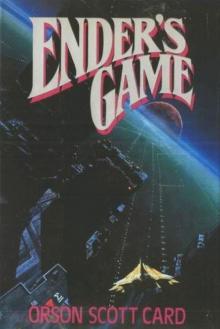 Ender's Game
Ender's Game Pathfinder
Pathfinder Children of the Fleet
Children of the Fleet Children of the Mind
Children of the Mind Ruins
Ruins Speaker for the Dead
Speaker for the Dead Ender's Shadow
Ender's Shadow Folk of the Fringe
Folk of the Fringe Hart's Hope
Hart's Hope Shadow of the Giant
Shadow of the Giant Empire
Empire Shadow Puppets
Shadow Puppets Earth Afire
Earth Afire First Meetings in Ender's Universe
First Meetings in Ender's Universe Maps in a Mirror: The Short Fiction of Orson Scott Card
Maps in a Mirror: The Short Fiction of Orson Scott Card Xenocide
Xenocide The Swarm: The Second Formic War
The Swarm: The Second Formic War Saints
Saints Seventh Son: The Tales of Alvin Maker, Volume I
Seventh Son: The Tales of Alvin Maker, Volume I Zanna's Gift
Zanna's Gift Duplex
Duplex Zanna's Gift- a Life in Christmases
Zanna's Gift- a Life in Christmases Hidden Empire
Hidden Empire Earth Awakens
Earth Awakens Visitors
Visitors Shadow of the Hegemon
Shadow of the Hegemon Alvin Jorneyman ttoam-4
Alvin Jorneyman ttoam-4 Federations
Federations The Gate Thief mm-2
The Gate Thief mm-2 First Meetings
First Meetings Capitol
Capitol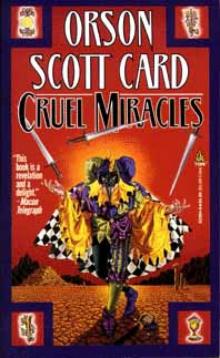 Cruel Miracles
Cruel Miracles Shadows in Flight, enhanced edition
Shadows in Flight, enhanced edition Ender's Game es-1
Ender's Game es-1 Ruins (Pathfinder Trilogy)
Ruins (Pathfinder Trilogy) Ender's Shadow ew-6
Ender's Shadow ew-6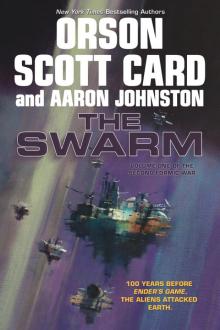 The Swarm
The Swarm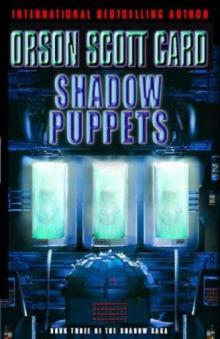 Card, Orson Scott - Ender's Saga 7 - Shadow Puppets
Card, Orson Scott - Ender's Saga 7 - Shadow Puppets Lost Boys: A Novel
Lost Boys: A Novel Mazer in Prison
Mazer in Prison Treason
Treason Heal Thyself
Heal Thyself The Call of Earth
The Call of Earth Songmaster
Songmaster Heartfire ttoam-5
Heartfire ttoam-5 Pastwatch
Pastwatch Gatefather
Gatefather The Ships of Earth: Homecoming: Volume 3
The Ships of Earth: Homecoming: Volume 3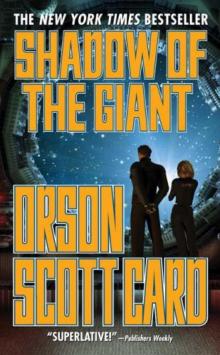 Orson Scott Card - Ender 08 - Shadow of the Giant
Orson Scott Card - Ender 08 - Shadow of the Giant Flux
Flux Speaker for the dead ew-2
Speaker for the dead ew-2 Grinning Man
Grinning Man Ruins sw-2
Ruins sw-2 Earth Unaware
Earth Unaware The Worthing Saga
The Worthing Saga Earthfall (Homecoming)
Earthfall (Homecoming) Card, Orson Scott - Ender's Saga 5 - Ender's Shadow
Card, Orson Scott - Ender's Saga 5 - Ender's Shadow The Abyss
The Abyss Magic Street
Magic Street Masterpieces
Masterpieces Prentice Alvin ttoam-3
Prentice Alvin ttoam-3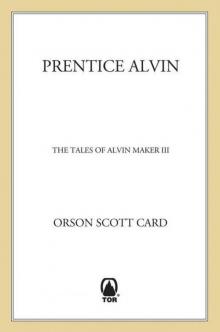 Prentice Alvin: The Tales of Alvin Maker, Volume III
Prentice Alvin: The Tales of Alvin Maker, Volume III Card, Orson Scott - Ender's Saga 3 - Xenocide
Card, Orson Scott - Ender's Saga 3 - Xenocide Homeless in Hell
Homeless in Hell Red Prophet: The Tales of Alvin Maker, Volume II
Red Prophet: The Tales of Alvin Maker, Volume II Earthborn (Homecoming)
Earthborn (Homecoming)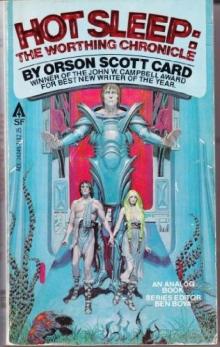 Hot Sleep
Hot Sleep The Hive
The Hive Rachel and Leah (Women of Genesis)
Rachel and Leah (Women of Genesis) Ender's World
Ender's World The Memory of Earth
The Memory of Earth Seventh Son ttoam-1
Seventh Son ttoam-1 Wyrms
Wyrms A Town Divided by Christmas
A Town Divided by Christmas Earth unavare (the first formic war)
Earth unavare (the first formic war) The Shadow of the Hegemon - Orson Scott Card
The Shadow of the Hegemon - Orson Scott Card Earthfall
Earthfall Lost Boys
Lost Boys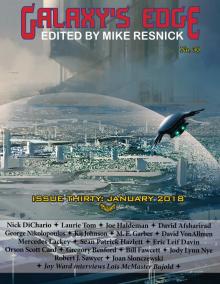 Galaxy's Edge Magazine
Galaxy's Edge Magazine Sarah: Women of Genesis: 1 (Women of Genesis (Forge))
Sarah: Women of Genesis: 1 (Women of Genesis (Forge)) The Crystal City: The Tales of Alvin Maker, Volume VI
The Crystal City: The Tales of Alvin Maker, Volume VI Xenocide ew-4
Xenocide ew-4 Earth Afire (The First Formic War)
Earth Afire (The First Formic War) Maps in a Mirror
Maps in a Mirror Pathfinder sw-1
Pathfinder sw-1 Red Prophet ttoam-2
Red Prophet ttoam-2 THE CRYSTAL CITY
THE CRYSTAL CITY 27 Short Stories
27 Short Stories Heartfire: The Tales of Alvin Maker, Volume V
Heartfire: The Tales of Alvin Maker, Volume V Alvin Journeyman: The Tales of Alvin Maker, Volume IV
Alvin Journeyman: The Tales of Alvin Maker, Volume IV Earth Awakens (The First Formic War)
Earth Awakens (The First Formic War) THE SHIPS OF EARTH
THE SHIPS OF EARTH The Changed Man
The Changed Man Future on Fire
Future on Fire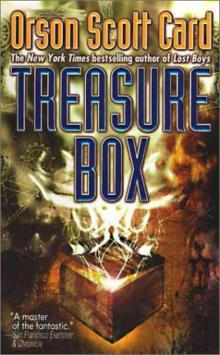 Treasure Box
Treasure Box The Gate Thief
The Gate Thief The Gate Thief (Mither Mages)
The Gate Thief (Mither Mages) First Meetings In the Enderverse
First Meetings In the Enderverse Earthborn
Earthborn Seventh Son
Seventh Son Pastwatch: The Redemption Of Christopher Columbus
Pastwatch: The Redemption Of Christopher Columbus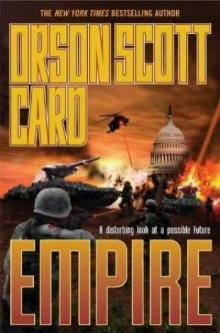 Empire e-1
Empire e-1 Keeper of Dreams
Keeper of Dreams Card, Orson Scott - Ender's Saga 1 - Ender's Game
Card, Orson Scott - Ender's Saga 1 - Ender's Game ALVIN JOURNEYMAN
ALVIN JOURNEYMAN The Lost Gate
The Lost Gate Feed The Baby Of Love
Feed The Baby Of Love Hot Sleep: The Worthing Chronicle
Hot Sleep: The Worthing Chronicle